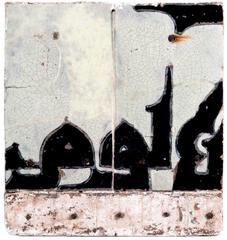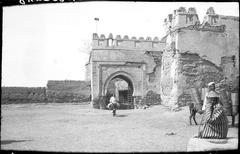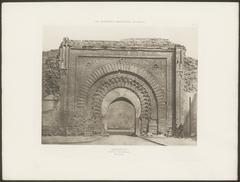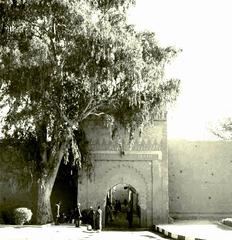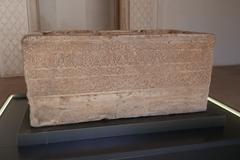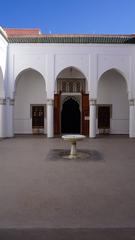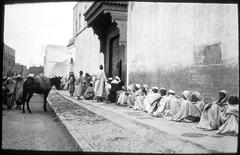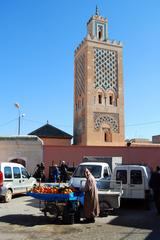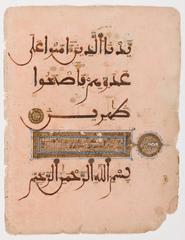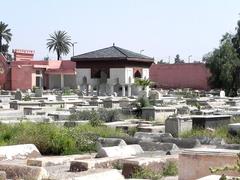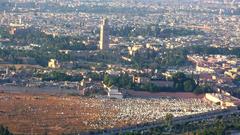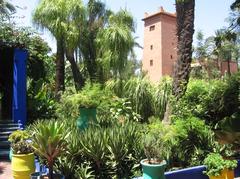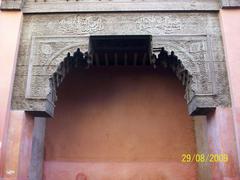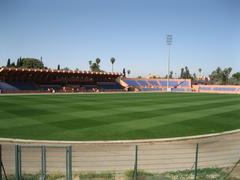Agdal Gardens Visiting Hours, Tickets, and Guide to Marrakesh Historical Sites
Date: 14/06/2025
Introduction to Agdal Gardens and Their Significance
Nestled just south of Marrakesh’s historic medina, the Agdal Gardens are a living testament to Morocco’s royal heritage, Islamic garden tradition, and environmental ingenuity. Established in 1157 by Abd al-Mu’min, the first Almohad caliph, these vast gardens—spanning between 500 and 700 hectares—blend geometric orchard layouts with advanced irrigation systems, embodying the Islamic vision of paradise while serving both practical and leisure purposes. The name “Agdal” comes from the Berber word for “walled meadow,” underscoring the gardens’ deep cultural ties to the Berber communities of the Atlas Mountains (Marrakech Riad; Archnet).
Over the centuries, the Agdal Gardens have been shaped by the Almohad, Saadian, and ‘Alawi dynasties, each leaving their mark on the gardens’ architecture and agricultural layout. Among the most notable features are the Sahraj el-Hana reservoir—known as the Tank of Health—and the Dar el-Beida palace, both of which reflect the gardens’ dual roles as sources of royal leisure and agricultural productivity. Today, visitors can enjoy tranquil orchards of orange, olive, fig, pomegranate, and other native species, all sustained by a network of underground khettaras channels that bring water from the High Atlas Mountains (FUNCI; Visit Marrakech).
Recognized as a UNESCO World Heritage Site since 1985, the Agdal Gardens are not only a serene escape from the city but also a vital example of sustainable landscape architecture and cultural continuity. This guide will explore the gardens’ history, layout, visiting information, and practical tips for making the most of your visit (Nomadic Matt; Garden Visit).
Historical Overview
Origins and Foundation
The Agdal Gardens were founded in 1157 by the Almohad caliph Abd al-Mu’min, who sought to create a productive and pleasure-filled oasis on the city’s edge (Marrakech Riad). The term “Agdal” reflects the garden’s origin as an enclosed, cultivated space—a tradition inherited from Berber agricultural practice (FUNCI).
The Almohads were known for their architectural innovation, and the gardens’ design combined geometric orchard plots with walkways lined by olive and citrus trees. The layout embodied the Islamic garden ideal: productive, ordered, and symbolic of paradise (Marrakech Riad).
Medieval Development and Irrigation
The gardens’ advanced irrigation system set them apart from other medieval gardens. Water was brought from the Ourika Valley in the High Atlas Mountains through underground khettaras and surface canals, feeding large reservoirs such as the Sahraj el-Hana, which provided both irrigation and a training pool for troops (Visit Marrakech). This system exemplifies the sophisticated hydraulic engineering of the Almohad era, which later influenced Islamic gardens throughout North Africa and Spain (FUNCI).
Saadian and ‘Alawi Renovations
After periods of neglect, the Saadian dynasty (16th–17th centuries) restored and replanted the gardens (Marrakech Riad). The most significant expansion came under Moulay Abderrahmane of the ‘Alawi dynasty (1822–1859), who enlarged the gardens and added the Dar el-Beida palace, a modest yet richly decorated retreat for the royal family (Marrakech Riad).
Architectural and Landscape Features
The Agdal Gardens feature a grid of orchards and olive-lined avenues, monumental water basins, and pavilions such as Dar El Hana. The entire site is enclosed by pisé (rammed earth) walls, adding to its sense of seclusion and exclusivity (FUNCI).
Notable Incidents
A pivotal moment in the gardens’ history occurred in 1873, when Sultan Mohammed IV drowned in the Sahraj el-Hana reservoir. This incident highlights the enduring relationship between the Moroccan monarchy and the Agdal Gardens (Marrakech Riad).
Cultural and UNESCO Significance
The Agdal Gardens are one of the most important surviving examples of Almohad landscape architecture (FUNCI). Their influence is evident in Maghrebi and Andalusian gardens. Their inscription as a UNESCO World Heritage Site in 1985 underscores their value as a cultural landscape of agricultural, royal, and artistic achievement (Marrakech Riad).
Botanical Diversity and Layout
The Agdal Gardens are a prime example of Moorish and Islamic garden design, with a geometric grid supporting efficient irrigation and lush greenery.
Key botanical features:
- Orchards: Orange, olive, pomegranate, fig, quince, and apricot trees.
- Palm groves: Date palms provide shade, supporting herbs and vegetables beneath.
- Vegetable plots: Traditionally grown under fruit trees using the “arsat” method.
- Aromatic plants: Herbs such as rosemary and mint enhance the gardens’ fragrance.
These plantings support urban biodiversity, providing habitats for birds and pollinators.
Water Management and Environmental Engineering
The gardens are sustained by a centuries-old water management system:
- Reservoirs: The Sahraj el-Hana and Es Sala basins serve both irrigation and aesthetic purposes.
- Gravity-fed irrigation: The gardens’ gentle slopes enable natural water flow.
- Khettaras and seguias: Underground and surface channels deliver water efficiently from the Atlas Mountains (Garden Visit).
This system reflects the ingenuity of the Almohad and Saadian dynasties and remains vital to the gardens’ sustainability.
Ecological and Environmental Significance
The Agdal Gardens provide critical ecological benefits within Marrakesh’s urban environment:
- Mitigating the urban heat island effect.
- Improving air quality and creating a humid microclimate.
- Supporting biodiversity with varied plant and animal species.
- Preventing soil erosion through perennial ground cover.
The gardens exemplify sustainable land management and the integration of environmental stewardship with cultural heritage.
Planning Your Visit: Hours, Tickets, and Tips
Location and Accessibility
Located about three kilometers south of Marrakesh’s medina, the Agdal Gardens are easily accessible via Petit Taxi or a 30-minute walk. The most direct route is along Rue Sidi Mimoun (Nomads Travel Guide).
Visiting Hours
- Official public access: Fridays and Sundays, from 9:00 am to 6:00 pm (Garden Visit).
- Note: Entry may be restricted when the King is in residence at the Royal Palace or during special events. Always check current hours with local sources before your visit (Egypt Tours Plus).
Tickets and Entry Fees
- Entry is free of charge; no tickets are required (Garden Visit).
- Some sources may mention small fees, but as of the latest updates, public access on open days is free. Always confirm with local authorities.
Facilities
- Minimal facilities: No cafés, shops, or regular restrooms inside. Carry water and snacks, and plan for limited amenities (Egypt Tours Plus).
- Main paths are generally flat and wide, though some may be unpaved or uneven.
What to See and Do
Strolling the Groves
Enjoy leisurely walks among the orange and olive groves, shaded by ancient trees and irrigated by the gardens’ ingenious water channels (Garden Visit).
The Tank of Health (Sahraj el-Hana)
This vast reservoir is the visual and functional heart of the gardens. The adjacent Dar El Hana pavilion offers picturesque views over the water and orchards (Egypt Tours Plus).
Historical Pavilions
Dar El Hana and the 19th-century pavilion built by Sultan Moulay Hassan are among the gardens’ most striking architectural features, reflecting their royal legacy (Egypt Tours Plus).
Photography and Nature Observation
Capture the interplay of light and shadow, reflections on the reservoir, and seasonal colors. The gardens are also a haven for birdwatchers.
Practical Tips for Visitors
- Best time to visit: Early morning or late afternoon, especially in summer. Spring offers blossoming trees and pleasant weather.
- What to bring: Comfortable shoes, water, sun protection, and a camera.
- Accessibility: Main paths suit most visitors, including those with limited mobility. Exercise caution in uneven areas.
- Facilities: Restrooms are limited; no cafés or shops on site.
Visitor Experience
- Tranquility: The Agdal Gardens are known for their peaceful atmosphere, offering a quiet refuge from the city (Egypt Tours Plus).
- Independent exploration: There are no regular guided tours or recreational facilities; visitors explore at their own pace.
- Cultural immersion: Strolling the gardens is an opportunity to experience Morocco’s deep-rooted garden traditions and landscape architecture (Nomads Travel Guide; Garden Visit).
Nearby Attractions
Extend your visit by exploring:
- The Menara Gardens
- The Royal Palace (exterior only)
- Marrakesh’s medina and souks
These sites are all within easy reach of the Agdal Gardens (Nomads Travel Guide).
UNESCO World Heritage Status
Since 1985, the Agdal Gardens, together with the Menara Gardens and Marrakesh’s medina, have been recognized as a UNESCO World Heritage Site, reflecting their global cultural and historical value (Nomads Travel Guide).
Frequently Asked Questions (FAQ)
Q: Are there any tickets required to enter the Agdal Gardens?
A: No, entry is free to the public on open days.
Q: What are the official visiting hours?
A: Fridays and Sundays, 9:00 am to 6:00 pm.
Q: Is the garden accessible for visitors with mobility challenges?
A: Main paths are generally accessible, but some areas may be uneven.
Q: What is the best time of year to visit?
A: Spring is ideal for blossoms; mornings and late afternoons are best in summer.
Q: Are there facilities inside the gardens?
A: Facilities are minimal; plan accordingly.
Q: What other attractions are nearby?
A: Menara Gardens, the Royal Palace, and Marrakesh medina.
Visuals and Media Suggestions
Enhance your visit by viewing images of the Tank of Health, orange groves, and pavilions. Use descriptive alt tags such as “Agdal Gardens Tank of Health reservoir” or “Orange groves in Marrakesh Agdal Gardens” for accessibility and SEO. An interactive map highlighting the gardens’ location and nearby attractions can also be useful.
Conclusion and Recommendations
The Agdal Gardens offer an extraordinary blend of history, nature, and tranquility in Marrakesh. From their 12th-century Almohad origins to their present status as a UNESCO World Heritage Site, they embody the enduring connection between Morocco’s royal legacy and sustainable land management. Visitors can enjoy peaceful walks, historical architecture, and natural beauty while exploring one of the city’s most significant cultural sites.
For a memorable visit, check current opening days, come prepared for limited facilities, and consider combining your trip with other nearby attractions. Download the Audiala app for up-to-date information and personalized travel tips. Stay connected on social media for more guides to Morocco’s rich heritage.
Sources and Further Reading
- Agdal Gardens Visiting Hours, Tickets, and Historical Guide in Marrakesh, 2024, Marrakech Riad (https://www.marrakech-riad.co.uk/2015/12/the-agdal-gardens/)
- Visiting the Agdal Gardens in Marrakesh: Hours, Tickets, and History, 2024, Archnet (https://www.archnet.org/sites/4742)
- Visiting the Agdal Gardens in Marrakesh: Hours, Tickets, and History, 2024, Nomadic Matt (https://www.nomadicmatt.com/travel-guides/morocco-travel-guide/marrakesh/)
- Agdal Gardens Visiting Hours, Tickets, and Guide to Marrakesh’s Historic Oasis, 2024, Egypt Tours Plus (https://www.egypttoursplus.com/agdal-gardens/)
- Agdal Gardens Visiting Hours, Tickets, and Historical Guide in Marrakesh, 2024, FUNCI (https://funci.org/cultura-sostenibilidad/development-cooperation/rehabilitation-of-the-agdal-of-marrakesh/?lang=en)
- Visiting the Agdal Gardens in Marrakesh: Hours, Tickets, and Historical Insights, 2024, Garden Visit (https://www.gardenvisit.com/gardens/aguedal_gardens)
- Visiting the Agdal Gardens in Marrakesh: Hours, Tickets, and History, 2024, Nomads Travel Guide (https://www.nomads-travel-guide.com/places/agdal-gardens-aguedal-park-gardens/)
